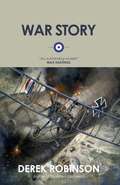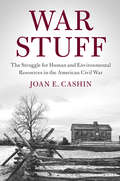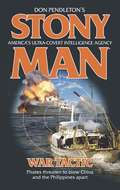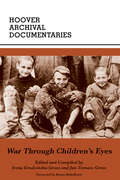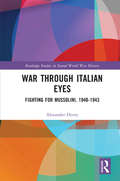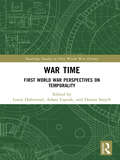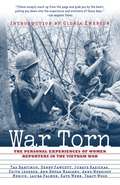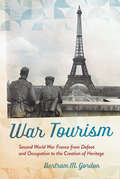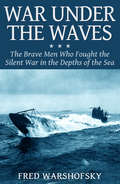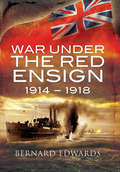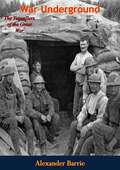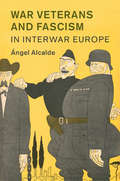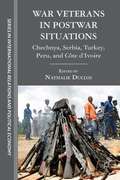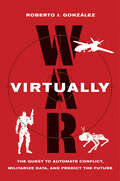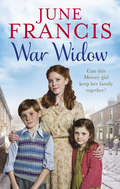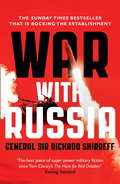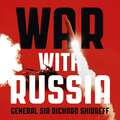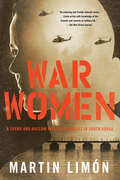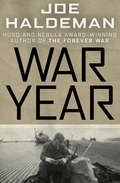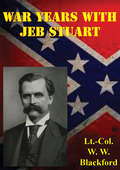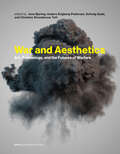- Table View
- List View
War Story
by Derek RobinsonFresh from school in June 1916, Lieutenant Oliver Paxton's first solo flight is to lead a formation of biplanes across the Channel to join Hornet Squadron in France. Five days later, he crash-lands at his destination, having lost his map, his ballast and every single plane in his charge. To his C.O. he's an idiot, to everyone else - especially the tormenting Australian who shares his billet - a pompous bastard. This is 1916, the year of the Somme, giving Paxton precious little time to grow from innocent to veteran.
War Stuff: The Struggle For Human And Environmental Resources In The American Civil War (Cambridge Studies On The American South )
by Joan E. CashinIn this path-breaking work on the American Civil War, Joan E. Cashin explores the struggle between armies and civilians over the human and material resources necessary to wage war. This war 'stuff' included the skills of white Southern civilians, as well as such material resources as food, timber, and housing. <P><P>At first, civilians were willing to help Confederate or Union forces, but the war took such a toll that all civilians, regardless of politics, began focusing on their own survival. Both armies took whatever they needed from human beings and the material world, which eventually destroyed the region's ability to wage war. In this fierce contest between civilians and armies, the civilian population lost. <P>Cashin draws on a wide range of documents, as well as the perspectives of environmental history and material culture studies. This book provides an entirely new perspective on the war era. Discusses the conduct of both Union and Confederate soldiers towards civilians in the South.<P> Will appeal to political historians and readers who are interested in wartime divisions inside the white Southern population.<P> Considers gender dynamics in the interactions between soldiers and female civilians.
War Tactic
by Don PendletonProfit Pirates Tensions between China and the Philippines are on the rise, and a series of pirate attacks on Filipino ports and vessels only makes things worse. Phoenix Force discovers that the pirates are armed with American weapons. As they struggle to neutralize the threat on the sea, Able Team must hunt down the mastermind behind the attacks before the United States is forced into war. Stony Man The best military fighters and cyber techs from around the world, the Stony Man teams are on the front lines of America's war against terror, wherever it takes them. These elite black ops warriors put their lives on the line in the name of freedom.
War Through Children's Eyes: The Soviet Occupation of Poland and the Deportations, 1939–1941 (Hoover Archival Documentaries)
by Jan T. Gross Jan Tomasz Gross Irena Grudzinska-GrossOn September 17, 1939, two weeks after the German invasion of Poland, Soviet troops occupied the eastern half of Poland and swiftly imposed a new political and economic order. Following a plebiscite, in early November the area was annexed to the Ukraine and Belorussia. Beginning in the winter of 1939–40, Soviet authorities deported over one million Poles, many of them children, to various provinces of the Soviet Union. After the German attack on the USSR in summer 1941, the Polish government in exile in London received permission from its new-found ally to organize military units among the Polish deportees and later to transfer Polish civilians to camps in the British-controlled Middle East. There the children were able to attend Polish-run schools.The 120 essays translated here were selected from compositions written by the students of these schools. What makes these documents unique is the perception of these witnesses: a child's eye view of events no adult would consider worth mentioning. In simple language, filled with misspellings and grammatical errors, the children recorded their experiences, and sometimes their surprisingly mature understanding, of the invasion and the Societ occupation, the deportations eastward, and life in the work camps and kolkhozes. The horrors of life in the USSR were vivid memories; privation, hunger, disease, and death had been so frequent that they became accepted commonplaces. Moreover, as the editors point out in their introductory study, these Polish children were not alone in their suffering. All the nationalities that came under Soviet rule shared their fate.
War Through Italian Eyes: Fighting for Mussolini, 1940-1943 (Routledge Studies in Second World War History)
by Alexander HenryThere is a popular notion that the Italian armed forces of the Second World War were an inferior fighting force. Despite the vast numbers taken prisoner, detailed studies of the experiences of these soldiers remain relatively uncommon and the value of this group to furthering our understanding of the Italian experience of war under Fascism is also rarely acknowledged. The existence in the National Archives of hundreds of pages of transcripts of covert British surveillance of Italian POWs has made it possible to engage with their experiences and opinions in much greater depth. The euphemistically termed ‘Special Reports’ present historians with a unique insight into how all levels of Italian soldiery viewed Fascist Italy’s experience of war, 1940-1943. This book examines reactions to Italian political leadership, the progress of the war, as well as Italian soldiers’ ‘everyday’ views on sex, war, the enemy, death, food, their allies, bravery, race, and killing. These fascinating documents reveal the complexity of the outlook of these men, which persistent – and influential – national stereotypes and historiographical trends fail to acknowledge.
War Time: First World War Perspectives on Temporality (Routledge Studies in First World War History)
by Louis Halewood Adam Luptak Hanna SmythThe International Society for First World War Studies’ ninth conference, ‘War Time’, drew together emerging and leading scholars to discuss, reflect upon, and consider the ways that time has been conceptualised both during the war itself and in subsequent scholarship. War Time: First World War Perspectives on Temporality, stemming from this 2016 conference, offers its readers a collection of the conference’s most inspiring and thought-provoking papers from the next generation of First World War scholars. In its varied yet thematically-related chapters, the book aims to examine new chronologies of the Great War and bring together its military and social history. Its cohesive theme creates opportunities to find common ground and connections between these sub-disciplines of history, and prompts students and academics alike to seriously consider time as alternately a unifying, divisive, and ultimately shaping force in the conflict and its historiography. With content spanning land and air, the home and fighting fronts, multiple nations, and stretching to both pre-1914 and post-1918, these ten chapters by emerging researchers (plus an introductory chapter by the conference organisers, and a foreword by John Horne) offer an irreplaceable and invaluable snapshot of how the next generation of First World War scholars from eight countries were innovatively conceptualising the conflict and its legacy at the midpoint of its centenary.
War Torn: The Personal Experiences of Women Reporters in the Vietnam War
by Laura Palmer Tad Bartimus Denby Fawcett Jurate Kazickas Edith Lederer Ann Mariano Anne Morrissy Merick Kate Webb Tracy WoodThis book is about our experiences as women reporters covering the Vietnam War from 1966 until the fall of Saigon in 1975. Each of us has written a chapter about what we saw and felt in Indochina--our adventures, fears, excitement, and the difficulties and loneliness. Vietnam was a unique war for all journalists, because there was no censorship. The U.S. military provided extraordinary access to combat operations. We could fly on bombing missions, parachute into hostile territory with an airborne unit, spend a week with the Special Forces in the jungle, hitch a ride on a chopper and land amid rocket and artillery as a battle raged, or be taken prisoner like a soldier. This access gave women reporters a chance to show that they could cover combat bravely and honorably, holding their own even under the most frightening and stressful circumstances.
War Tourism: Second World War France from Defeat and Occupation to the Creation of Heritage
by Bertram M. GordonAs German troops entered Paris following their victory in June 1940, the American journalist William L. Shirer observed that they carried cameras and behaved as "naïve tourists." One of the first things Hitler did after his victory was to tour occupied Paris, where he was famously photographed in front of the Eiffel Tower.Focusing on tourism by German personnel, military and civil, and French civilians during the war, as well as war-related memory tourism since, War Tourism addresses the fundamental linkages between the two. As Bertram M. Gordon shows, Germans toured occupied France by the thousands in groups organized by their army and guided by suggestions in magazines such as Der Deutsche Wegleiter fr Paris [The German Guide for Paris]. Despite the hardships imposed by war and occupation, many French civilians continued to take holidays. Facilitated by the Popular Front legislation of 1936, this solidified the practice of workers' vacations, leading to a postwar surge in tourism.After the end of the war, the phenomenon of memory tourism transformed sites such as the Maginot Line fortresses. The influx of tourists with links either directly or indirectly to the war took hold and continues to play a significant economic role in Normandy and elsewhere. As France moved from wartime to a postwar era of reconciliation and European Union, memory tourism has held strong and exerts significant influence across the country.
War Trials: Investigation of a Soldier and the Trauma of Iraq
by Will YatesWar Trials tells the gripping and in-depth true story of a British soldier’s role in the drowning of an Iraqi teenager in May 2003, the devastating investigation and resulting court martial. This narrative non-fiction tracks the soldier’s life from tight-knit broken family home in Merseyside through deadly urban conflict in the Middle East, to a different battle fought against PTSD while he awaited a military tribunal back in the UK. The military court case in 2006 marked the first of its kind relating to the Iraq war and a case that opened the flood gates of multiple investigations and inquiries into the conduct of soldiers overseas. Based upon rigorous new research, this book’s untold personal story explores the horrors of battle and the chaos of a post-war city and a young soldier’s struggle against depression, suicide attempts and deep sense of being let down by the army he sought to serve. This soldier would eventually endure numerous investigations and face the threat of the International Criminal Court for war crimes but these are the shocking events that started it all. It is the compelling story of a contentious military campaign with little preparation for the disastrous fall out; the soldiers pushed to the limit who maintained a wall of a silence after doing the unthinkable; and a floating body of dead child who came to symbolize a generation lost to war.
War Under Waves
by Fred WarshofskyWar Under the Waves, first published in 1962, is a non-technical overview of the history of the military submarine. Beginning with the Turtle of the American Revolutionary War, the Hunley of the Civil War, and continuing on to famous World War One and Two submarines (such as the USS Growler and USS Harder), War Under the Waves provides a look at look at the crews and their submarines as they engaged the enemy and helped make the submarine one of the most important tools of naval warfare.
War Under the Red Ensign, 1914–1918: 1914-1918
by Bernard Edwardshe Kaisers determination to starve Britain into surrender and the development of his Navy and the U-boats in particular meant that Britains merchant navy was in the front line throughout the Great War.This book charts the progress of the war at sea which began with the sinking of the oil tanker San Wilfrido off Cuxhaven only eight hours after the official declaration of war. The merchantman Glitra was the first victim of a German U-boat (U–17) on 20 October 1914 she was to be joined by many, many more. As the war on land intensified so the naval struggle grew ever more bitter. As vividly described there were many incidents of atrocious behavior, amounting to war crimes, by the attackers against their hapless victims; sinking of lifeboats, machine-gunning of survivors, attacks without any warning designed to cause maximum casualties.We learn of instances where the weak gallantly fought back such as the duel between Captain Bissett-Smiths Otaki (with one gun) and the heavily armed German surface raider Mwe. Although he went down with his ship, Captain Smith was posthumously awarded the VC, and remains the only merchant seaman so honored.War under the Red Ensign contains many inspiring and shocking accounts of war at sea and is a gripping read.
War Underground: The Tunnellers of the Great War
by Alexander BarrieThis is the definitive history of tunneling and mining operations on the Western Front in World War I. A truly fascinating and little appreciated aspect of that terrible conflict that only now is being properly understood.
War Veterans and Fascism in Interwar Europe (Studies in the Social and Cultural History of Modern Warfare #50)
by Ángel AlcaldeThis book explores, from a transnational viewpoint, the historical relationship between war veterans and fascism in interwar Europe. Until now, historians have been roughly divided between those who assume that 'brutalization' (George L. Mosse) led veterans to join fascist movements and those who stress that most ex-soldiers of the Great War became committed pacifists and internationalists. Transcending the debates of the brutalization thesis and drawing upon a wide range of archival and published sources, this work focuses on the interrelated processes of transnationalization and the fascist permeation of veterans' politics in interwar Europe to offer a wider perspective on the history of both fascism and veterans' movements. A combination of mythical constructs, transfers, political communication, encounters and networks within a transnational space explain the relationship between veterans and fascism. Thus, this book offers new insights into the essential ties between fascism and war, and contributes to the theorization of transnational fascism. Offers a Europe-wide transnational perspective on the complex phenomenon of fascism Analyzes the cultural, sociological and political origins of fascism and its proliferations across Europe Transcends the traditional paradigm of the 'brutalization' thesis and challenges conventional views of war veterans' identities and history
War Veterans and the World after 1945: Cold War Politics, Decolonization, Memory (Routledge Studies in Modern History)
by Ángel Alcalde Xosé M. Núñez SeixasThis book examines war veterans’ history after 1945 from a global perspective. In the Cold War era, in most countries of the world there was a sizeable portion of population with direct war experience. This edited volume gathers contributions which show the veterans’ involvement in all the major historical processes shaping the world after World War II. Cold War politics, racial conflict, decolonization, state-building, and the reshaping of war memory were phenomena in which former soldiers and ex-combatants were directly involved. By examining how different veterans’ groups, movements and organizations challenged or sustained the Cold War, strived to prevent or to foster decolonization, and transcended or supported official memories of war, the volume characterizes veterans as largely independent and autonomous actors which interacted with societies and states in the making of our times. Spanning historical cases from the United States to Hong-Kong, from Europe to Southern Africa, from Algeria to Iran, the volume situates veterans within the turbulent international context since World War II.
War Veterans in Postwar Situations
by Nathalie DuclosThis edited volume deals with the reintegration and trajectories of intrastate or interstate war veterans. It raises the question of the effects of the war experience on ex-combatants with regards, in particular, to the perpetuation of a certain level of violence as well as the maintaining of structures, networks, and war methods after the war.
War Virtually: The Quest to Automate Conflict, Militarize Data, and Predict the Future
by Roberto J. GonzálezA critical look at how the US military is weaponizing technology and data for new kinds of warfare—and why we must resist. War Virtually is the story of how scientists, programmers, and engineers are racing to develop data-driven technologies for fighting virtual wars, both at home and abroad. In this landmark book, Roberto J. González gives us a lucid and gripping account of what lies behind the autonomous weapons, robotic systems, predictive modeling software, advanced surveillance programs, and psyops techniques that are transforming the nature of military conflict. González, a cultural anthropologist, takes a critical approach to the techno-utopian view of these advancements and their dubious promise of a less deadly and more efficient warfare. With clear, accessible prose, this book exposes the high-tech underpinnings of contemporary military operations—and the cultural assumptions they're built on. Chapters cover automated battlefield robotics; social scientists' involvement in experimental defense research; the blurred line between political consulting and propaganda in the internet era; and the military's use of big data to craft new counterinsurgency methods based on predicting conflict. González also lays bare the processes by which the Pentagon and US intelligence agencies have quietly joined forces with Big Tech, raising an alarming prospect: that someday Google, Amazon, and other Silicon Valley firms might merge with some of the world's biggest defense contractors. War Virtually takes an unflinching look at an algorithmic future—where new military technologies threaten democratic governance and human survival.
War Volunteering in Modern Times
by Christine G. Krüger Sonja LevsenExploring volunteering as a characteristic of modern wars, this book examines why individuals go to war. It studies the motivations, social backgrounds and military experiences of war volunteersin a wide range of conflicts since the French Revolution, and helps to interpret the relationship between war and society in modern times. "
War With Russia: A Menacing Account
by General Sir ShirreffA chilling political thriller that is dangerously close to becoming realityAccording to General Sir Richard Shirreff, recently retired Deputy Supreme Allied Commander Europe we are already at war with Russia. Putin is waging war by unconventional means, including sponsoring terrorist attacks in Ukraine and in the UK and also cyber warfare. This book shows how war with Russia could erupt into conventional warfare with the bloodiest and most appalling consequences if the necessary steps are not taken urgently. As Admiral James G Stavridis, US Navy, former Supreme Allied Commander Europe, says 'You fail to read this book at your peril. Like any 'strongman', the Russian president's reputation for strength is everything. Lose momentum, fail to give the people what they want and he fails. Putin has already demonstrated that he has no intention of failing. He has already started a lethal dynamic which, unless checked right now, could see him invade the Baltic states. Russia's invasion and seizure of Georgia in 2008 was our 'Rhineland moment'. We ignored the warning signs - as we did back in the 1930s - and we made it 'business as usual'.Crimea in 2014 was the President's 'Sudetenland moment' and again he got away with it. Since 2014 Russia has invaded Ukraine. The Baltics could be next.Our political leaders assume that nuclear deterrence will save us. General Sir Richard Shirreff shows us why this will not wash.
War With Russia: A Menacing Account
by General Sir ShirreffA chilling political thriller that is dangerously close to becoming realityAccording to General Sir Richard Shirreff, recently retired Deputy Supreme Allied Commander Europe we are already at war with Russia. Putin is waging war by unconventional means, including sponsoring terrorist attacks in Ukraine and in the UK and also cyber warfare. This book shows how war with Russia could erupt into conventional warfare with the bloodiest and most appalling consequences if the necessary steps are not taken urgently. As Admiral James G Stavridis, US Navy, former Supreme Allied Commander Europe, says 'You fail to read this book at your peril. Like any 'strongman', the Russian president's reputation for strength is everything. Lose momentum, fail to give the people what they want and he fails. Putin has already demonstrated that he has no intention of failing. He has already started a lethal dynamic which, unless checked right now, could see him invade the Baltic states. Russia's invasion and seizure of Georgia in 2008 was our 'Rhineland moment'. We ignored the warning signs - as we did back in the 1930s - and we made it 'business as usual'.Crimea in 2014 was the President's 'Sudetenland moment' and again he got away with it. Since 2014 Russia has invaded Ukraine. The Baltics could be next.Our political leaders assume that nuclear deterrence will save us. General Sir Richard Shirreff shows us why this will not wash.
War With Russia: The chillingly accurate political thriller of a Russian invasion of Ukraine, now unfolding day by day just as predicted
by General Sir Shirreff'You fail to read this book at your peril' - Admiral James G Stavridis, US Navy, former Supreme Allied Commander Europe.Closely modelled on his NATO experience of war gaming future conflicts, 2017 War With Russia is a chilling account of where we are heading if we fail to recognise the threat posed by the Russian president. Written by the recently retired Deputy Supreme Allied Commander Europe and endorsed by senior military figures, this book shows how war with Russia could erupt with the bloodiest and most appalling consequences if the necessary steps are not taken urgently. President Putin said: 'We have all the reasons to believe that the policy of containment of Russia which was happening in the 18th, 19th and 20th century is still going on...' And 'If you press the spring, it will release at some point. Something you should remember.'Like any 'strongman', the Russian president's reputation for strength is everything. Lose momentum, fail to give the people what they want and he fails. The President has already demonstrated that he has no intention of failing. He has already started a lethal dynamic which, unless checked right now, could see him invade the Baltic states.Russia's invasion and seizure of Georgia in 2008 was our 'Rhineland moment'. We ignored the warning signs - as we did back in the 1930s - and we made it 'business as usual'.Crimea in 2014 was the President's 'Sudetenland moment' and again he got away with it. Since 2014 Russia has invaded Ukraine. The Baltics could be next.Our political leaders assume that nuclear deterrence will save us. General Sir Richard Shirreff shows us why this will not wash.(P)2017 Hodder & Stoughton
War Women (A Sergeants Sueño and Bascom Novel #15)
by Martin LimonTasked with covering up a tabloid report about high-ranking officers, US Army CID Agents George Sueño and Ernie Bascom discover a dark web of systemic issues that have potentially fatal consequences. South Korea, 1970s: Sergeant First Class Cecil B. Harvey, a senior NCO in charge of 8th Army&’s classified documents, has long been a friend (willing or unwilling) to Sergeants George Sueño and Ernie Bascom. So when he goes missing with a top-secret document that even a glance at could get an officer court-martialed, Sueño and Bascom take it upon themselves to find him.Meanwhile, Overseas Observer reporter Katie Byrd Worthington is back to make life difficult for top Army brass. When she lands in a Korean jail cell, Sueño and Bascom are sent to get her out—and negotiate against the publication of an incriminating story about the mistreatment of women in the military that could land important officials in hot water. But what they learn will make it hard for them to stay silent.
War Year (Vietnam Ser.)
by Joe HaldemanA tour of duty through the worst that the world has to offer Before his time as a professor of writing at the Massachusetts Institute of Technology, before penning multiple Nebula and Hugo Award–winning novels and stories, Joe Haldeman was a soldier in Vietnam, an experience that changed him and colored much of what he has written. War Year is Haldeman&’s first novel and his first attempt to describe what he saw in Vietnam and give insight into what happened for the benefit of those who weren&’t there. The minimalist War Year follows the life of John Farmer, a combat engineer, over the course of a year in Vietnam. John undergoes training, and then, along with his fellow soldiers, does whatever it takes to survive in unforgiving conditions. Powerful and affecting, War Year reaches its highest peaks as it describes with enduring truth the sights and experiences of what it was like to be in the humid jungles of Vietnam in 1968. This ebook features an illustrated biography of Joe Haldeman including rare images from the author&’s personal collection.
War Years With Jeb Stuart
by Lieutenant Colonel W. W. Blackford C.S.A."Characterized by precision of statement and clarity of detail, W.W. Blackford's memoir of his service in the Civil War is one of the most valuable to come out of Robert E. Lee's Army of Northern Virginia. It also provides a critically important perspective on one of the best-known Confederate cavalrymen, Major General J.E.B. Stuart.Blackford was thirty years old when the war began, and he served from June 1861, until January, 1864, as Stuart's adjutant, developing a close relationship with Lee's cavalry commander. He subsequently was a chief engineer and a member of the staff at the cavalry headquarters. Because Stuart was mortally wounded in 1864, he did not leave a personal account of his career. Blackford's memoir, therefore, is a vital supplement to Stuart's wartime correspondence and reports.In a vivid style, Blackford describes the life among the cavalrymen, including scenes of everyday camp life and portraits of fellow soldiers both famous and obscure. He presents firsthand accounts of, among others, the battles of First Bull Run, the Peninsular campaign, Second Bull Run, Antietam, Fredericksburg, Gettysburg, the Wilderness, and Cold Harbor, and describes his feelings at witnessing the surrender at Appomattox."-Print ed.
War and Aesthetics: Art, Technology, and the Futures of Warfare (Prisms: Humanities and War #1)
by Jens Bjering, Anders Engberg-Pedersen, Solveig Gade, and Christine Strandmose ToftA provocative edited collection that takes an original approach toward the black box of military technology, surveillance, and AI—and reveals the aesthetic dimension of warfare.War and Aesthetics gathers leading artists, political scientists, and scholars to outline the aesthetic dimension of warfare and offer a novel perspective on its contemporary character and the construction of its potential futures. Edited by a team of four scholars, Jens Bjering, Anders Engberg-Pedersen, Solveig Gade, and Christine Strandmose Toft, this timely volume examines warfare through the lens of aesthetics, arguing that the aesthetic configurations of perception, technology, and time are central to the artistic engagement with warfare, just as they are key to military AI, weaponry, and satellite surveillance.People mostly think of war as the violent manifestation of a political rationality. But when war is viewed through the lens of aesthesis—meaning perception and sensibility—military technology becomes an applied science of sensory cognition. An outgrowth of three war seminars that took place in Copenhagen between 2018 and 2021, War and Aesthetics engages in three main areas of inquiry—the rethinking of aesthetics in the field of art and in the military sphere; the exploration of techno-aesthetics and the wider political and theoretical implications of war technology; and finally, the analysis of future temporalities that these technologies produce. The editors gather various traditions and perspectives ranging from literature to media studies to international relations, creating a unique historical and scientific approach that broadly traces the entanglement of war and aesthetics across the arts, social sciences, and humanities from ancient times to the present. As international conflict looms between superpowers, War and Aesthetics presents new and illuminating ways to think about future conflict in a world where violence is only ever a few steps away.ContributorsLouise Amoore, Ryan Bishop, Jens Bjering, James Der Derian, Anthony Downey, Anders Engberg-Pedersen, Solveig Gade, Mark B. Hansen, Caroline Holmqvist, Vivienne Jabri, Caren Kaplan, Phil Klay, Kate McLoughlin, Elaine Scarry, Christine Strandmose Toft, Joseph Vogl, Arkadi Zaides
